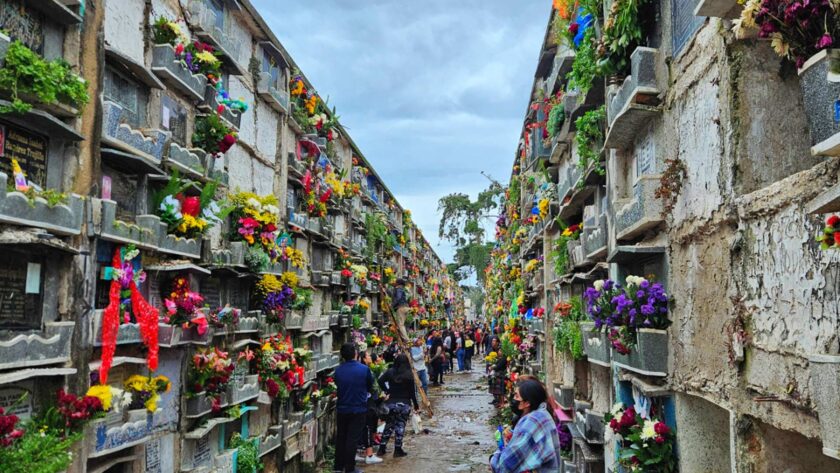Brief overview of All Saints Day globally
All Saints Day, celebrated on November 1st each year, is a significant occasion observed in various cultures and nations worldwide. This solemn yet joyous day holds unique cultural and religious importance, encompassing diverse traditions and customs that honor the deceased. The global observance of All Saints Day reflects a collective veneration of saints and departed loved ones, although the practices and customs can vary widely from one country to another.
In many parts of the world, All Saints Day serves as a day of remembrance and homage to saints, martyrs, and departed individuals. While the specific customs and practices differ from culture to culture, the underlying essence remains constant: a day dedicated to honoring those who have passed away.
In various Christian denominations, particularly in Western Christianity, All Saints Day is celebrated with church services, prayers, and the lighting of candles to remember and pay tribute to saints and loved ones. The day also symbolizes a celebration of life and a reflection on the afterlife, often marked by solemn yet uplifting rituals.
All Saints Day traditions differ significantly across regions and countries. In some areas, it involves visits to cemeteries to clean and decorate the graves of the deceased with flowers, candles, and offerings. Families gather to remember their departed loved ones, sharing stories and anecdotes, and often enjoying special foods prepared for the occasion.
In some cultures, such as Mexico’s Day of the Dead (Día de Muertos), the celebrations span several days, blending indigenous rituals with Christian beliefs. Elaborate altars are constructed to honor the deceased, adorned with marigolds, photos, favorite foods, and personal items that symbolize the lives of those being commemorated.
Unity in Diversity
The beautiful aspect of All Saints Day is how it unites people from diverse backgrounds in a shared commemoration of life and legacy. Whether in the Philippines, where families spend the night at the graves of their departed, or in Spain, where traditional foods and public events mark the occasion, the universal theme is one of remembrance, respect, and celebration.
This global perspective on All Saints Day provides a rich tapestry of customs and practices, each contributing to the colorful mosaic of worldwide traditions. As we explore the specific observances in various countries, we gain a deeper appreciation for the global significance and cultural diversity of this day of remembrance.
In the subsequent sections, we’ll delve into the distinct and vibrant traditions of All Saints Day in Guatemala, exploring the unique customs and rituals that make this celebration particularly special in this Central American nation.
Stay tuned to discover the rich cultural heritage and practices observed on All Saints Day in Guatemala, showcasing the beauty and depth of its traditions.
All Saints Day in Guatemala: A Vibrant Tapestry of Cultural Celebrations
Guatemala, a country renowned for its rich cultural heritage and diverse traditions, holds a unique and colorful celebration of All Saints Day. On November 1st, this Central American nation comes alive with vibrant festivities that blend indigenous Mayan rituals with Catholic traditions, creating a celebration that is both solemn and exuberant.
Blend of Mayan and Catholic Traditions
The observance of All Saints Day in Guatemala beautifully intertwines Mayan customs with the Catholic feast day, resulting in a unique and deeply spiritual celebration. The fusion of these traditions is evident in the way families honor their departed loved ones through a fascinating array of rituals, ceremonies, and decorations.
Visits to Cemeteries and Family Gatherings
One of the hallmark traditions of All Saints Day in Guatemala is the commemoration of the deceased through visits to cemeteries. Families gather to meticulously clean and adorn the graves of their loved ones with vibrant flowers, candles, and intricate decorations. It’s a time for reflection, remembrance, and honoring the legacies of those who have passed on.
Creation of Colorful Kites: A Symbolic Tradition
A particularly distinctive feature of the Guatemalan All Saints Day celebration is the custom of creating and flying intricately designed kites. These large, colorful kites, known as “barriletes,” are meticulously crafted and flown high in the skies above cemeteries. Symbolically, these kites are believed to carry messages from the living to the departed souls and are thought to ward off evil spirits.
Feasting and Traditional Foods
As part of the celebrations, families prepare and share traditional foods, such as “fiambre,” a special dish made only for this occasion. Fiambre is a unique salad composed of various meats, vegetables, and spices, prepared with ancestral recipes passed down through generations. It is a dish that reflects the diversity and cultural richness of Guatemala.
Music, Dance, and Art
The festive ambiance of All Saints Day is further heightened by the sounds of traditional music and dance. Local artisans also showcase their skills by creating elaborate decorations and crafts, adding to the vibrant and joyful atmosphere of the celebrations.
Origins and Significance
All Saints’ Day, known as “Día de Todos los Santos” in Guatemala, is an important religious observance deeply rooted in both Catholic and indigenous beliefs. Stemming from ancient Mayan rituals that venerated the dead, the current celebration combines these pre-Hispanic customs with Catholic traditions introduced during the Spanish conquest.
The day holds profound significance, as it’s believed to be a time when the souls of the deceased return to visit their loved ones on Earth. Guatemalans use this occasion to honor and remember their departed relatives, creating an atmosphere of reverence and connection between the living and the spirits of the afterlife.
Preparations and Customs
In the days leading up to All Saints’ Day, Guatemalans begin their preparations by cleaning and decorating the gravesites of their loved ones. Families visit cemeteries to adorn the tombs with vibrant flowers, candles, and a variety of offerings. Marigolds, known as “flor de muerto” or flower of the dead, hold particular significance and are used to decorate the graves as their vibrant hues are believed to guide the spirits of the departed back to the earthly realm.
The atmosphere in the cemeteries is transformed into a kaleidoscope of colors as families meticulously arrange intricately woven carpets of flowers, pine needles, and colored sawdust, forming elaborate designs along the paths to the gravesites. These stunning displays reflect the artistic prowess and reverence Guatemalans have for their departed loved ones.
Kite Festival – A Unique Tradition
One of the most iconic and distinctive customs of All Saints’ Day in Guatemala is the tradition of flying kites. Known as “barriletes gigantes” or giant kites, these colossal, intricately designed kites carry deep cultural symbolism. The belief is that the kites act as a communication medium between the living and the departed souls.
These massive kites, often reaching sizes of up to 25 feet in diameter, are meticulously crafted by local artisans and communities. They are adorned with colorful designs, intricate patterns, and messages dedicated to the deceased. The kites are flown on this day, their soaring heights representing a connection between the earthly realm and the spiritual world, allowing messages to reach the departed souls.
Traditional Foods and Offerings
As part of the commemoration, families prepare traditional dishes and offerings to share with both the living and the departed. Guatemalans prepare and enjoy special foods such as “fiambre,” a traditional salad containing a variety of meats, vegetables, and pickled ingredients. It is believed that the deceased return to taste the flavors of the dish prepared in their honor.
Additionally, families bring the deceased’s favorite food and drink to the gravesites as offerings, inviting the spirits to partake in the earthly pleasures they once enjoyed.
Community and Belief in Unity
The celebrations of All Saints’ Day in Guatemala are not just about honoring the departed; they also emphasize the importance of community and togetherness. Families and communities come together to support each other, sharing stories and memories of their loved ones. The sense of unity is palpable as people from all walks of life gather to pay their respects, creating a shared atmosphere of reverence and solidarity.
Conclusion
All Saints’ Day in Guatemala is a remarkable testament to the country’s rich cultural tapestry, blending indigenous traditions with Catholic rituals to create a unique and vibrant celebration of life and the afterlife. Through colorful decorations, heartfelt customs, and a profound sense of community, Guatemalans honor their ancestors and celebrate the enduring connections between the living and the departed. This celebration stands as a beautiful representation of the country’s deep-rooted traditions and serves as a poignant reminder of the importance of remembrance and unity in the face of loss.
As the kites soar high above the decorated graves, and the aroma of traditional dishes fills the air, Guatemala commemorates All Saints’ Day, embracing a profound belief in the eternal connection between the living and the departed.




